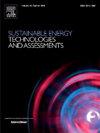In silico dispersion modelling for the safety assessment of ammonia as marine fuel
IF 7.1
2区 工程技术
Q1 ENERGY & FUELS
Sustainable Energy Technologies and Assessments
Pub Date : 2025-02-24
DOI:10.1016/j.seta.2025.104247
引用次数: 0
Abstract
In this study simulations are carried out to predict ammonia dispersion in the ambient environment and, consequently, assess specific safety aspects with respect to an emergency underwater release of fuel ammonia from a ship with particular emphasis in areas where personnel can be potentially exposed. Specifically, simulations are performed employing a commercial Computational Fluid Dynamics (CFD) numerical code in which both the physics of ammonia dissolution in water in conjunction with subsequent evaporation in ambient air and the vessel-specific details such as geometry and discharge parameters are considered. Subsequently, the computational method is used to simulate selected discharge scenarios and thereby to define zones of increased ammonia concentrations and potentially hazardous areas to personnel based on the Acute Exposure Guideline Levels for Hazardous Substances. These scenarios account for ambient conditions such as wind speed and direction and also the discharge system specifications. Results include the impact of both sea current velocity and direction to the fate of released ammonia and indicate ammonia concentration levels at different areas on board and around the vessel. On the basis of these results, it may be conjectured that if the ship maintains its maneuvering capability in case of an emergency scenario, then it is feasible to maintain a safe side by attempting to position the ship axis parallel to the prevailing seawater current. In addition, the maximum height above the sea surface where relatively low concentration of ammonia is observed for the specific geometry and cases considered, is determined. In view of this, the model can be used as a tool for dispersion analysis to investigate and possibly support the use of ammonia as a marine fuel. This can be of interest to various stakeholders including authorities as well as classification societies that have introduced tentative rules and guidelines in relation to ammonia-fueled ships.
求助全文
约1分钟内获得全文
求助全文
来源期刊

Sustainable Energy Technologies and Assessments
Energy-Renewable Energy, Sustainability and the Environment
CiteScore
12.70
自引率
12.50%
发文量
1091
期刊介绍:
Encouraging a transition to a sustainable energy future is imperative for our world. Technologies that enable this shift in various sectors like transportation, heating, and power systems are of utmost importance. Sustainable Energy Technologies and Assessments welcomes papers focusing on a range of aspects and levels of technological advancements in energy generation and utilization. The aim is to reduce the negative environmental impact associated with energy production and consumption, spanning from laboratory experiments to real-world applications in the commercial sector.
 求助内容:
求助内容: 应助结果提醒方式:
应助结果提醒方式:


